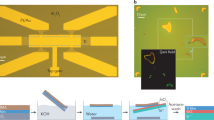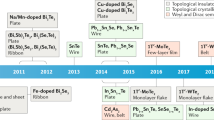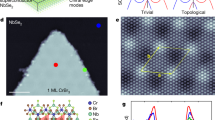Abstract
Electrical charges on the boundaries of topological insulators favour forward motion over back-scattering at impurities, producing low-dissipation, metallic states that exist up to room temperature in ambient conditions. These states have the promise to impact a broad range of applications from electronics to the production of energy, which is one reason why topological insulators have become the rising star in condensed-matter physics. There are many challenges in the processing of these exotic materials to use the metallic states in functional devices, and they present great opportunities for the chemistry and materials science research communities.
This is a preview of subscription content, access via your institution
Access options
Subscribe to this journal
Receive 12 print issues and online access
$259.00 per year
only $21.58 per issue
Buy this article
- Purchase on Springer Link
- Instant access to full article PDF
Prices may be subject to local taxes which are calculated during checkout




Similar content being viewed by others
References
Anderson, P. W. Absence of diffusion in certain random lattices. Phys. Rev. 109, 1492–1505 (1958).
Nomura, K., Koshino, M. & Ryu, S. Topological delocalization of two-dimensional massless Dirac fermions. Phys. Rev. Lett. 99, 146806 (2007).
Murakami, S., Nagaosa, N. & Zhang, S.-C. Spin-Hall insulator. Phys. Rev. Lett. 93, 156804 (2004).
Kane, C. L. & Mele, E. J. Z2 topological order and the quantum spin Hall effect. Phys. Rev. Lett. 95, 146802 (2005).
Bernevig, B. A., Hughes, T. L. & Zhang, S.-C. Quantum spin Hall effect and topological phase transition in HgTe quantum wells. Science 314, 1757–1761 (2006).
Konig, M. et al. Quantum spin Hall insulator state in HgTe quantum wells. Science 318, 766–770 (2007).
Fu, L., Kane, C. L. & Mele, E. J. Topological insulators in three dimensions. Phys. Rev. Lett. 98, 106803 (2007).
Moore, J. E. & Balents, L. Topological invariants of time-reversal-invariant band structures. Phys. Rev. B 75, 121306 (2007).
Roy, R. Z2 classification of quantum spin Hall systems: An approach using time-reversal invariance. Phys. Rev. B 79, 195321 (2009).
Fu, L. & Kane, C. L. Topological insulators with inversion symmetry. Phys. Rev. B 76, 045302 (2007).
Hsieh, D. et al. A topological Dirac insulator in a quantum spin Hall phase. Nature 452, 970–974 (2008).
Zhang, H. et al. Topological insulators in Bi2Se3, Bi2Te3 and Sb2Te3 with a single Dirac cone on the surface. Nature Phys. 5, 438–442 (2009).
Xia, Y. et al. Observation of a large-gap topological-insulator class with a single Dirac cone on the surface. Nature Phys. 5, 398–402 (2009).
Chen, Y. L. et al. Experimental realization of a three-dimensional topological insulator, Bi2Te3 . Science 325, 178–181 (2009).
Hsieh, D. et al. A tunable topological insulator in the spin helical Dirac transport regime. Nature 460, 1101–1105 (2009).
Roushan, P. et al. Topological surface states protected from backscattering by chiral spin texture. Nature 460, 1106–1109 (2009).
Zhang, T. et al. Experimental demonstration of topological surface states protected by time-reversal symmetry. Phys. Rev. Lett. 103, 266803 (2009).
Alpichshev, Z. et al. STM imaging of electronic waves on the surface of Bi2Te3: Topologically protected surface states and hexagonal warping effects. Phys. Rev. Lett. 104, 016401 (2010).
Seo, J. et al. Transmission of topological surface states through surface barriers. Nature 466, 343–346 (2010).
Gomes, K. K. et al. Quantum imaging of topologically unpaired spin-polarized Dirac fermions. Preprint available at http://arxiv.org/abs/0909.0921 (2009).
Yan, B. et al. Theoretical prediction of topological insulators in thallium-based III-V-VI2 ternary chalcogenides. Europhys. Lett. 90, 37002 (2010).
Lin, H. et al. Single-Dirac-cone topological surface states in the TlBiSe2 class of topological semiconductors. Phys. Rev. Lett. 105, 036404 (2010).
Chadov, S. et al. Tunable multifunctional topological insulators in ternary heusler compounds. Nature Mater. 9, 541–545 (2010).
Lin, H. et al. Half-heusler ternary compounds as new multifunctional experimental platforms for topological quantum phenomena. Nature Mater. 9, 546–549 (2010).
Peng, H. et al. Aharonov-Bohm interference in topological insulator nanoribbons. Nature Mater. 9, 225–229 (2010).
Bachtold, A. et al. Aharonov-Bohm oscillations in carbon nanotubes. Nature 397, 673–675 (1999).
Xiu, F. et al. Manipulating surface states in topological insulator nanoribbons. Nature Nanotech. 6, 216–221 (2011).
Analytis, J. G. et al. Two-dimensional surface state in the quantum limit of a topological insulator. Nature Phys. 6, 960–964 (2010).
Qu, D.-X., Hor, Y. S., Xiong, J., Cava, R. J. & Ong, N. P. Quantum oscillations and Hall anomaly of surface states in the topological insulator Bi2Te3 . Science 329, 821–824 (2010).
Hor, Y. S. et al. P-type Bi2Se3 for topological insulator and low-temperature thermoelectric applications. Phys. Rev. B 79, 195208 (2009).
Analytis, J. G. et al. Bulk fermi surface coexistence with Dirac surface state in Bi2Se3: A comparison of photoemission and Shubnikov-de Haas measurements. Phys. Rev. B 81, 205407 (2010).
Chen, Y. L. et al. Massive Dirac fermion on the surface of a magnetically doped topological insulator. Science 329, 659–662 (2010).
Kong, D. et al. Topological insulator nanowires and nanoribbons. Nano Lett. 10, 329–333 (2009).
Cha, J. J. et al. Magnetic doping and Kondo effect in Bi2Se3 nanoribbons. Nano Lett. 10, 1076–1081 (2010).
Kong, D. et al. Few-layer nanoplates of Bi2Se3 and Bi2Te3 with highly tunable chemical potential. Nano Lett. 10, 2245–2250 (2010).
Dang, W., Peng, H., Li, H., Wang, P. & Liu, Z. Epitaxial heterostructures of ultrathin topological insulator nanoplate and graphene. Nano Lett. 10, 2870–2876 (2010).
Venkatasubramanian, R., Siivola, E., Colpitts, T. & O'Quinn, B. Thin-film thermoelectric devices with high room-temperature figures of merit. Nature 413, 597–602 (2001).
Zhang, Y. et al. Crossover of the three-dimensional topological insulator Bi2Se3 to the two-dimensional limit. Nature Phys. 6, 584–588 (2010).
Li, Y. Y. et al. Intrinsic topological insulator Bi2Te3 thin films on Si and their thickness limit. Adv. Mater. 22, 4002–4007 (2010).
Teweldebrhan, D., Goyal, V. & Balandin, A. A. Exfoliation and characterization of bismuth telluride atomic quintuples and quasi-two-dimensional crystals. Nano Lett. 10, 1209–1218 (2010).
Ding, Z., Viculis, L., Nakawatase, J. & Kaner, R. B. Intercalation and solution processing of bismuth telluride and bismuth selenide. Adv. Mater. 13, 797–800 (2001).
Hong, S. S. et al. Ultrathin topological insulator Bi2Se3 nanoribbons exfoliated by atomic force microscopy. Nano Lett. 10, 3118–3122 (2010).
Bando, H. et al. The time-dependent process of oxidation of the surface of Bi2Te3 studied by X-ray photoelectron spectroscopy. J. Phys. Condens. Matter 12, 5607 (2000).
Fu, L. & Kane, C. L. Superconducting proximity effect and Majorana fermions at the surface of a topological insulator. Phys. Rev. Lett. 100, 096407 (2008).
Garate, I. & Franz, M. Inverse spin-galvanic effect in the interface between a topological insulator and a ferromagnet. Phys. Rev. Lett. 104, 146802 (2010).
Bonaccorso, F., Sun, Z., Hasan, T. & Ferrari, A. C. Graphene photonics and optoelectronics. Nature Photon. 4, 611–622 (2010).
Chasmar, R. P. & Stratton, R. The thermoelectric figure of merit and its relation to thermoelectric generators. J. Electron. Control 7, 52–72 (1959).
Xu, S.-Y. et al. Discovery of several large families of topological insulator classes with backscattering-suppressed spin-polarized single-Dirac-cone. Preprint available at http://arxiv.org/abs/arXiv:1007.5111 (2010).
Chen, H., Zhu, W., Xiao, D. & Zhang, Z. CO oxidation facilitated by robust surface states on Au-covered topological insulators. Phys. Rev. Lett. 107, 056804 (2011).
Qi, X.-L. & Zhang, S.-C. The quantum spin Hall effect and topological insulators. Phys. Today 63, 33–38 (2010).
Acknowledgements
We have benefited from discussions with Shou-Cheng Zhang and Zhong Wang to improve this Perspective. Our research on topological insulators is supported by the Keck Foundation and DARPA MESO project (no. N66001-11-1-4105). Y. C. acknowledges the support from King Abdullah University of Science and Technology (KAUST) Investigator Award (no. KUS-l1-001-12).
Author information
Authors and Affiliations
Corresponding author
Ethics declarations
Competing interests
The authors declare no competing financial interests.
Rights and permissions
About this article
Cite this article
Kong, D., Cui, Y. Opportunities in chemistry and materials science for topological insulators and their nanostructures. Nature Chem 3, 845–849 (2011). https://doi.org/10.1038/nchem.1171
Published:
Issue Date:
DOI: https://doi.org/10.1038/nchem.1171
This article is cited by
-
Rational design of superior catalysts from topological semimetals with nontrivial energy window
Rare Metals (2024)
-
Tailoring Bi2Te3 edge with semiconductor and metal properties under electron beam irradiation
Nano Research (2022)
-
Topological Insulator \(\hbox {Bi}_{2}\hbox {Se}_{3}\) Films on Silicon Substrates
Journal of Electronic Materials (2020)
-
Electrical detection of current generated spin in topological insulator surface states: Role of interface resistance
Scientific Reports (2019)
-
Inherent Surface Properties of Adsorbent-Free Ultrathin Bi2Se3 Topological Insulator Platelets
Scientific Reports (2019)



